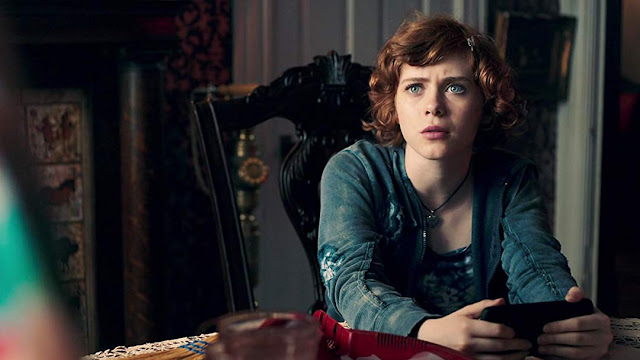Movie Review: Nancy Drew and the Hidden Staircase
Sometimes when you’re in the grip of an impending anxiety attack or despairing over the horrendous and traumatic opening scene in It Chapter Two all you can do is seek solace in watching a clever teen sleuthing around her sleepy small town to prove the existence of ghosts with her BFFS. Yes. We’re talking Nancy freakin’ Drew. Is it enough to banish the blues over the unforgivable fates the It writers and directors bestowed upon their queer characters? Not entirely but it does help! Nostalgia and sentimentality is REAL, man. Real.
Movie Review: Nancy Drew and the Hidden Staircase
Directed by Katt Shea Nancy Drew and the Hidden Staircase takes the iconic literary character and puts a modern spin on her. Impulsive and often acting on pure instinct the young super sleuth has a rambunctiousness and messiness that her literary counterpart lacks. Relatively new to River Heights, Nancy contends with her recent move from Chicago with her kindly father, and esteemed lawyer Carson (Sam Trammell, This Is Us) while also mourning her mother’s untimely death.
Loosely based on the 1959 revised edition* of the novel of the same name The Hidden Staircase reimagines the goody-two-shoes girl-next-door Nancy Drew as a mischievous and scrappy teen with dope skateboarding moves and a fierce love for her girlfriends.
When Derek (Evan Castelloe, Sharp Objects) a self-absorbed jock from her highschool, creates a cruel video of her best friend Bess (Mackenzie Graham, Darlin’) and it goes viral, Nancy gathers her girls and pulls off some restorative justice in one of the most epic stunts River Heights has ever seen.
Two words? Shower sabotage.
Let that sink in for a sec.
Good?
Good.
After Nancy’s shenanigans piss off one too many people River Heights’ curmudgeonly Sheriff Marchbanks (Jay DeVon Johnson, What Men Want) gives the spunky teen hours upon hours of trash duty… until an encounter with the eccentric Flora Turnbull (Linda Lavin, Santa Clarita Diet) seeking help for her “haunted” house, the historical Twin Elms.
Thus, Nancy becomes entangled in Twin Elms dark past and the notorious legend that back in 1885 the owner of the Elms and a hog farmer, Malcolm Colfax, was slighted by the woman he loved and went on a murderous rampage, bricking her and the man she loved into the walls of a house. Alive. The very same walls that surround Flora.
Twin Elms, she insists, is haunted by his vengeful spirit and she needs a way to halt his nightly violent streak. Flora’s great-niece (and local mean girl), Helen joins in on the investigation, and mayhem ensues.
The light bulbs burst into showers of glass and sparks, Helen gets dragged around the house by a humanoid black mist, Nancy gets clobbered by kitchen cabinets that are flung open by unseen hands, and a pig-faced man prowls the halls.
Unwilling to believe a ghost is behind all the madness, Nancy commits herself to scope out Flora’s whimsical wonderland of a house-- think: grass painted in cotton candy hues, a veritable flock of plastic pink garden flamingos, and enough curios to fill a small museum--for clues.
Sophia Lillis (It: Chapter One) brings daring and charm to the iconic literary character in her geeky, punk-rock iteration of the crime solver. With her messy bob of ginger hued hair and perpetual grunge lewk, Lillis’s acting radiates relatability. Lillis’s Nancy is a scrappy, energetic and infinitely lovable lead character. She has magnetism when she shares the screen with her River Heights friends and when she’s solo and shredding up the streets on her skateboard to rousing choruses of punk feminist anthems.
The supporting characters are also stellar. Nancy’s besties Bess --a science whiz-- and George --a human tween embodiment of a Honey Badger-- (Zoë Renee, The Quad) bring more female power to the film, celebrating the STEM field and, in George’s case, reinforcing the strength of the friendship between the trio, especially when Helen, a girl George deems public enemy number one, tries to lend a hand with the crime-solving efforts.
Helen at first blush looks shallow, spoiled and full of herself. But her character soon proves to have far more layers. Played with great heart by Laura Wiggins (Cradle Swapping) Helen is guarded, skeptical, and fiercely protective of her elderly Great-Aunt. Although at first she seems at odds with Nancy, it quickly becomes evident that Helen isn’t a hater but, instead, fearful that Nancy would publicly humiliate her Great-Aunty with the same mocking brand of “justice” she used against Derek.
Nancy’s wise-cracking pie-baking aunt Hannah (Andrea Anders, Young Sheldon) and River Heights’ young deputy Patrick (Andrew Matthew Welch, Purity Falls) round out the rest of The Hidden Staircase’s characters.
Director Katt Shea brings a balanced female perspective to the film and positively showcases female friendships and the many shapes and forms they take. With such an empowering spirit, there’s no place for one-dimensional mean girl nonsense here. And it’s beautiful.
With its tight ninety minutes run time, strikingly detailed set design, and engaging characters pushing along an already compelling plot, Nancy Drew and the Hidden Staircase is an irresistibly playful and clever feel-good movie that’s entertaining for all ages.
Highly recommended.
* The 1959 revised edition is written by Harriet Adams -- the head ghostwriter of the Nancy Drew series (published under the pseudonym Carolyn Keene) and the daughter of the man who created many of the Nancy Drew characters, Edward Stratemeyer.
All images from IMDB









Comments
Post a Comment